
Mayonnaise is a thick, creamy emulsion typically made from oil, egg yolks, vinegar or lemon juice, and seasonings. It has a smooth, rich texture and is commonly used as a spread, dip, or base for sauces and dressings. This creamy, healthy version of a vegan and egg-free mayonnaise is made with cashews. It is great for both vegans and vegetarians alike. If you are in search of an eggless, plant based, veg mayo recipe, look no further!
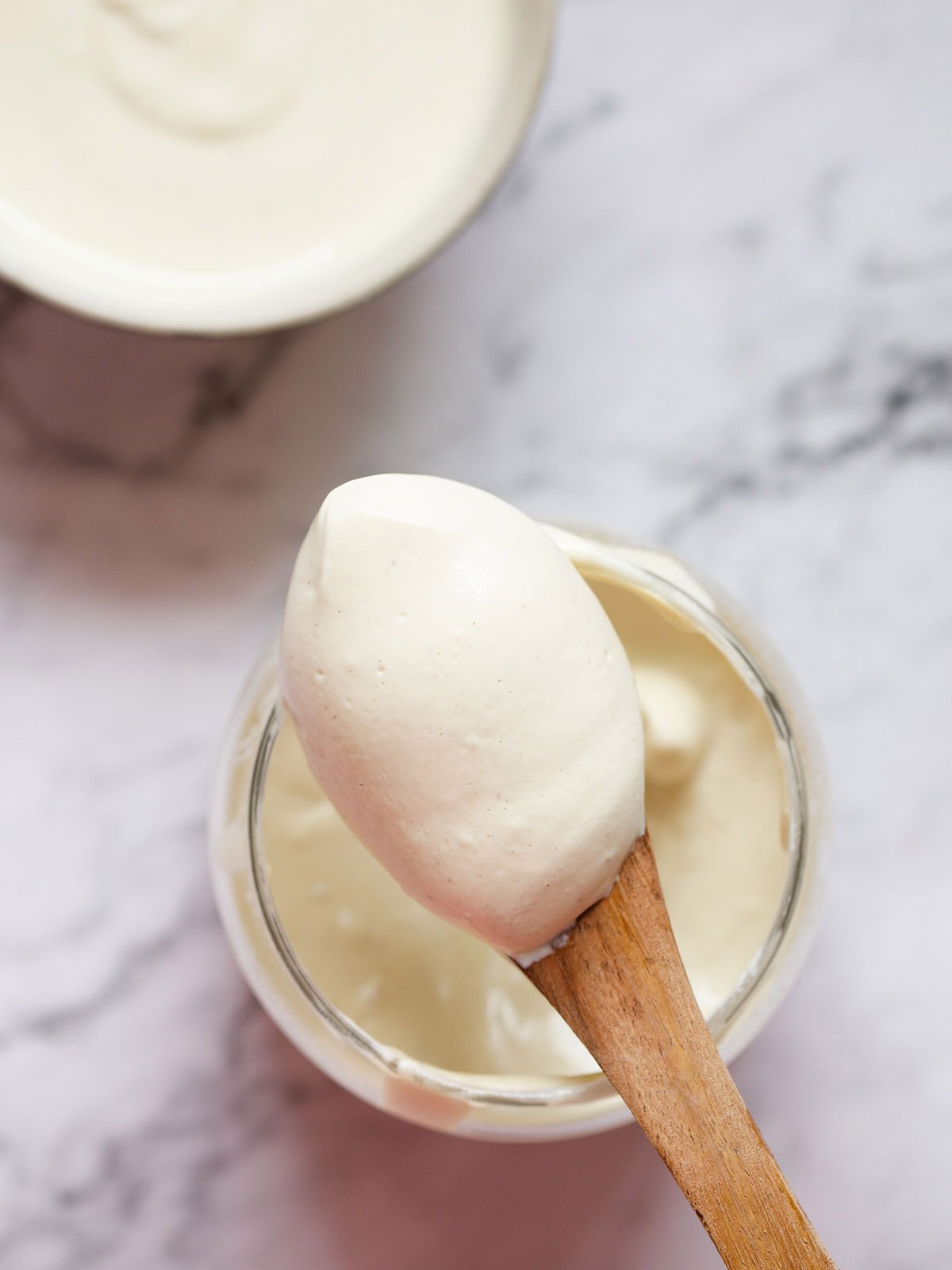

About This Mayonnaise Recipe
Many of you have requested an eggless mayonnaise recipe, and after many trials, I have found a winner. This is a fool-proof recipe that tastes just like the real thing. It’s thick, creamy, and works perfectly in any recipe that calls for mayonnaise.
In my quest for the best veg mayonnaise recipe, I tried making mayo with dairy milk, almond milk, and soy milk but the results were not great.
The oil would separate when the mayo was refrigerated and sometimes the mayo would not thicken even after repeated blending.
Then I tested making mayo with cashews. Initially, I got a cashew paste and not something light or fluffy the way mayo is.
I tested with different combinations of oil and vinegar and finally came to these perfect proportions of a creamy, light, and smooth veg mayonnaise which actually looks like traditional mayonnaise and tastes even better than your classic mayo.
This vegan mayonnaise uses pantry staples that you likely already have on hand. Apple cider vinegar, dijon mustard (or dried mustard powder), sugar, salt, pepper, and a touch of turmeric for color are combined with soaked cashews.
The mixture is blended until emulsified, light, and fluffy and I swear it tastes as good (if not better!) than regular mayonnaise.
I share two recipes for eggless mayonnaise here. One is the classic version minus the eggs and the second is the Japanese style mayo which is sweeter.
I have shared the ingredients and method for Japanese mayo in the notes section of the recipe card. You choose whichever you like or prefer.
Regular Mayo vs Eggless Mayo
Normal mayonnaise made in the French style uses egg yolks that are emulsified with oil and vinegar. In an effort to come up with a vegan, eggless version, I turned to cashews, which are the darling of the vegan world.
Soaked cashews are a magical ingredient that can be used in everything from salad dressing to vegan cheese making. Their lack of skin and softer consistency combined with their high-fat content makes them a perfect doppelgänger for dairy products.
If you are allergic to eggs, avoiding dairy, or are vegan, this eggless mayonnaise recipe is sure to delight you.
I’m not sure how it is where you’re from, but it is often difficult to find vegan mayonnaise at the grocery store, but finding cashews, oil and vinegar is a breeze! As an added bonus, it is much cheaper than store-bought vegan mayonnaise.
How do you thicken veg mayonnaise
The trick to making thick mayonnaise is emulsifying it properly. For this process, you’ll need a blender, immersion blender, or food processor, as hand beating just won’t have the power needed to blend the nuts into a cream.
To properly emulsify something – which means that you are for all intents and purposes combining water and oil – you should start your blender on low speed and slowly work it up to high.
If your mayonnaise is coming out too runny, it is likely that you used a tad too much water in making it. You can attempt to rectify this by soaking an extra tablespoon or two of cashews, then draining them thoroughly and adding them to your mix.
If the result is now a bit too thick, slowly drizzle in a bit of oil while the blender is on until the proper consistency is achieved.


Step-by-Step Guide
How to make Eggless Mayonnaise
Prep Cashews
1. Rinse 1 cup cashews (125 grams) thoroughly in water. Drain all the water and discard it.
Tip: Use raw unsalted cashews for this recipe. It is okay to use cashew pieces if they are less expensive, as long as they are raw and unsalted.


2. Place the cashews in a bowl and cover with enough warm water. Soak them for 30 minutes.
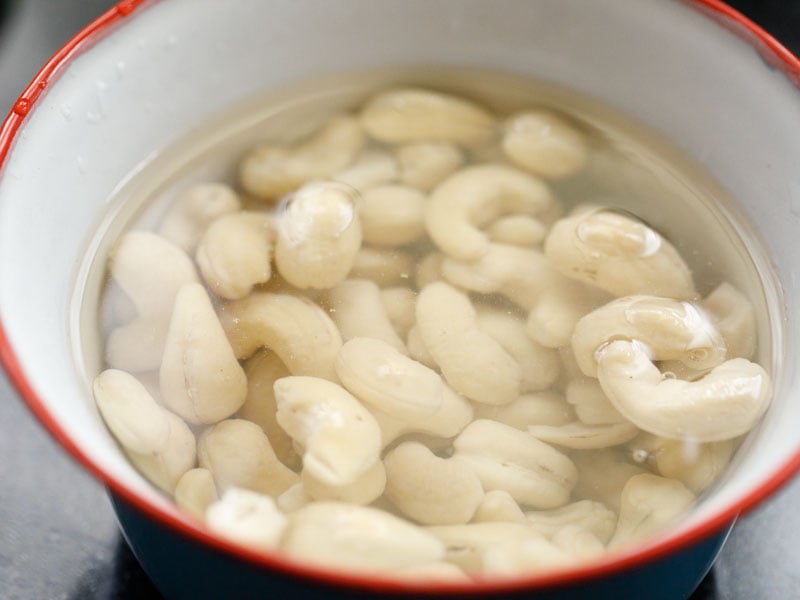

Blend & Make Mayonnaise
3. Drain and discard all the water from the soaked cashews and add nuts to a blender. Also add 1 teaspoon dijon mustard, ½ teaspoon raw sugar, 1 pinch of turmeric powder, 6 black peppercorns, ½ teaspoon rock salt.
Tip: You can sub 1 teaspoon ground mustard powder in place of dijon mustard.


4. Add 1 tablespoon apple cider vinegar or lemon juice.
Tip: If you prefer a Japanese style vegan mayonnaise, which is slightly sweeter and tangier, simply increase the amount of sugar used to 1 tablespoon, the mustard to 2 teaspoons, and the apple cider vinegar (or lemon juice) to 2 tablespoons and follow the same method.
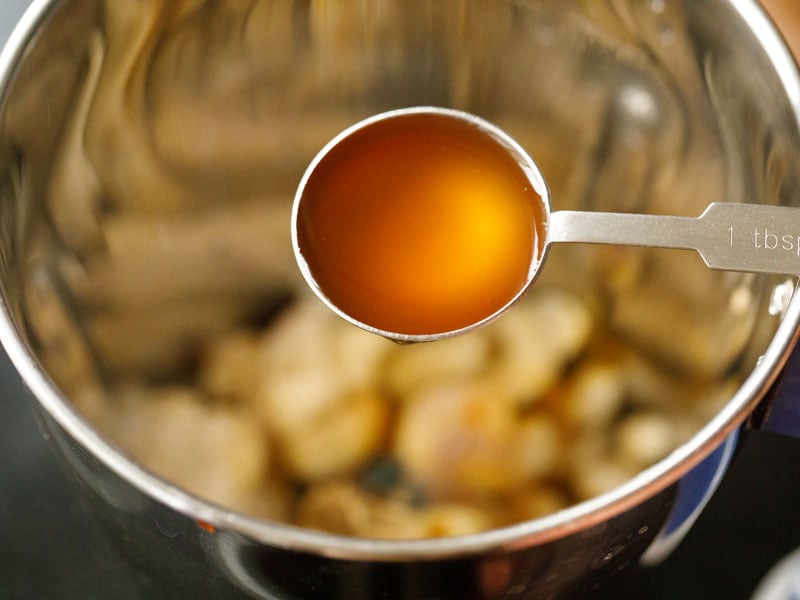

5. Add 2 tablespoons sunflower oil or any neutral tasting oil.
Tip: It is very important to use a neutral oil when making mayonnaise. Some good options are canola, vegetable, grapeseed, or avocado oil. Do not use oil that has a unique aroma or flavor as your mayo will also have it. Avoid coconut oil, peanut oil, sesame oil, olive oil.
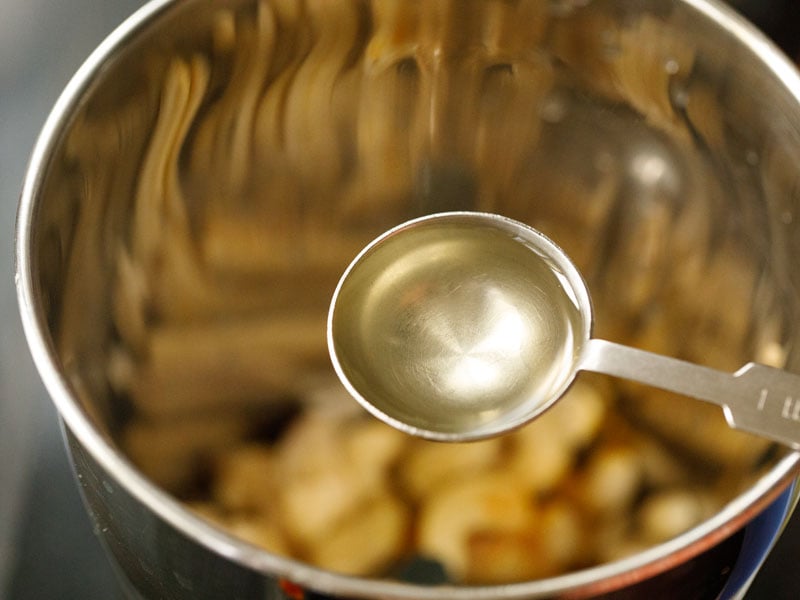

6. While the blender is running, slowly add 7 to 8 tablespoons water in parts and blend until smooth and creamy.
Tip: Need to use this eggless mayonnaise straightaway? Only add 4 to 5 tablespoons of water. The veg mayonnaise will thicken in the refrigerator, so 7 to 8 tablespoons water works perfectly if you have time to let it set up. If you opt to use less water to use the mayo right away, be sure to use the entire recipe or it will become too thick in the refrigerator.
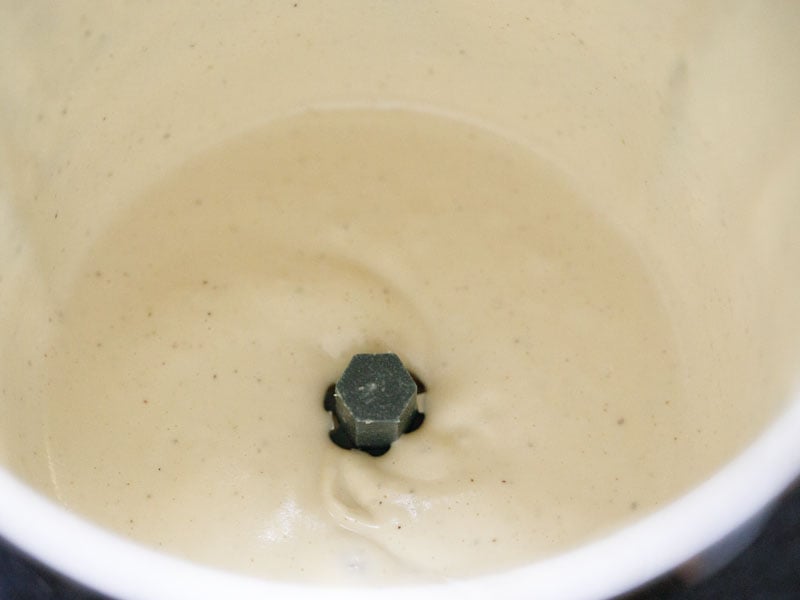

7. Pour your completed vegan mayonnaise into a clean jar or airtight container. Seal it tightly and refrigerate.
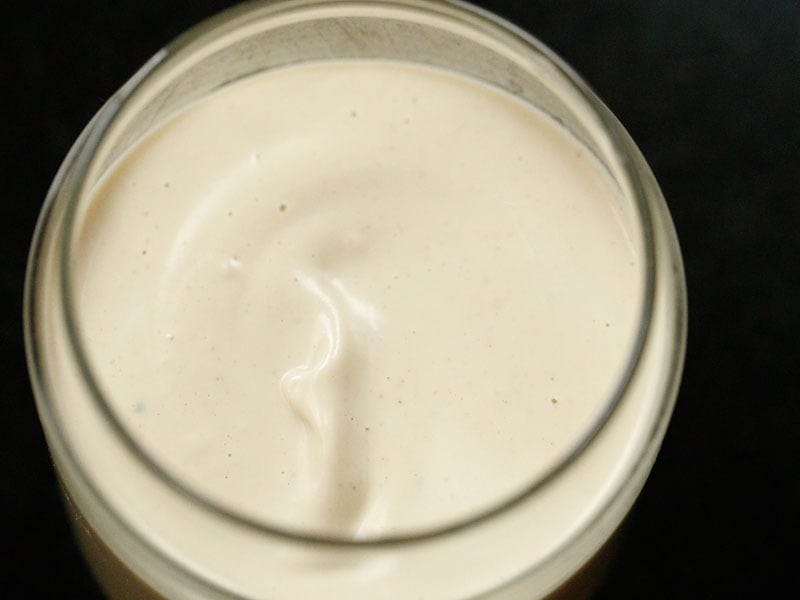

Serving Suggestions
It brings a perfect balance of creaminess and tang.
- Toppings & Dips: Serve it as a dip for Veg Momos, or drizzle over French Fries, Potato Wedges, or savory cabbage pancakes. You can also use it in fusion-style dips or as a creamy chutney base.
- Versatile Spread and Filling: Use this mayo as a spread on bread or toast, or mix it into savory pies like Tomato Pie. It also makes a great addition to vegetable-filled sandwiches or as a creamy layer in bakes.
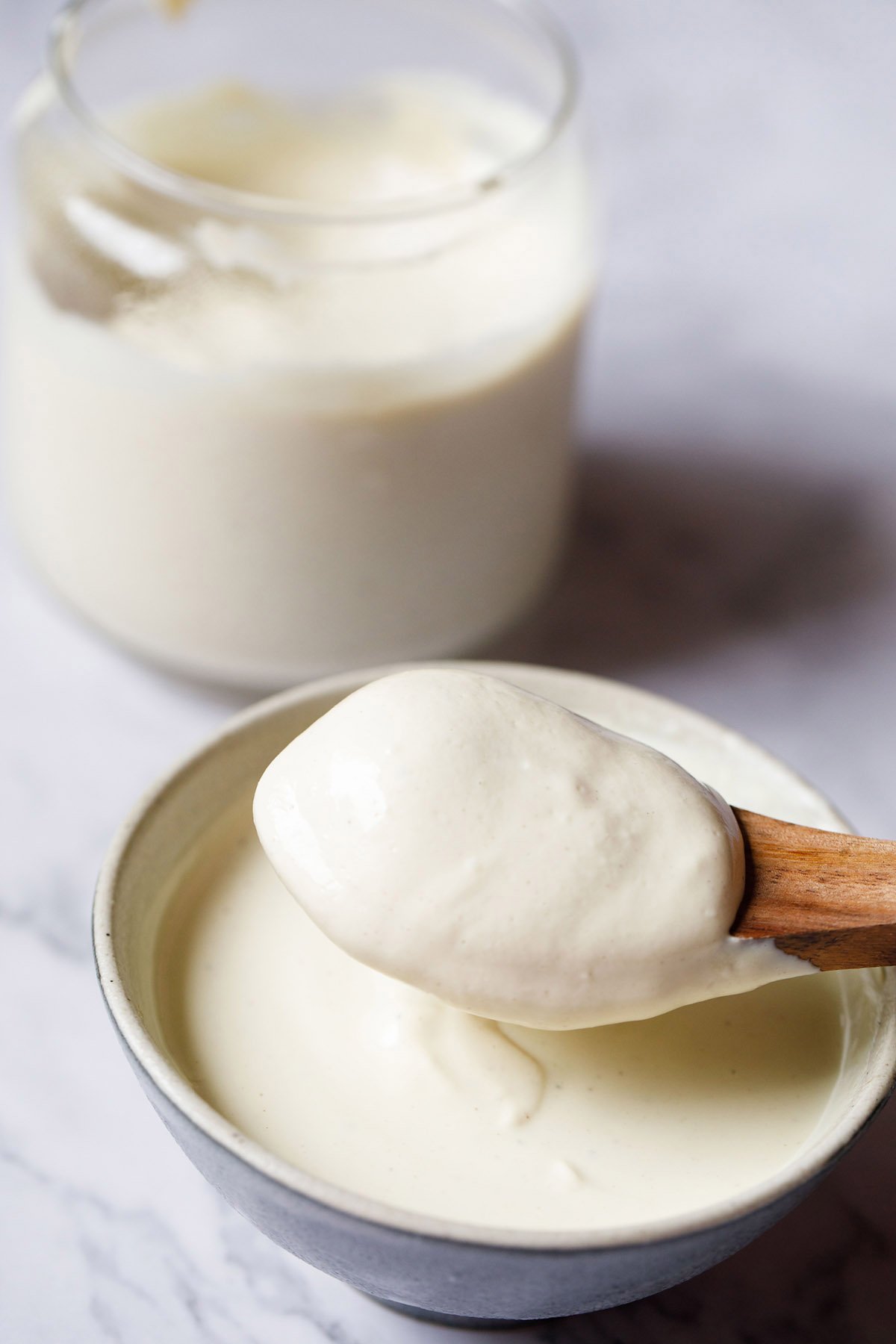

Storage
This eggless mayo stays good for a month in the refrigerator. You can also freeze it for 3 months.
Be sure to use an airtight container to store your eggless mayonnaise. This delicate mix will take on the flavors of anything in the air, so if you store cut onions or garlic in the refrigerator, you may end up with an unwanted flavor.
Expert Tips
- Cashews: Use raw, unsalted cashews—whole or broken pieces are fine, as long as they are not roasted or salted.
- Oil: A neutral-flavored oil is essential for the right taste. Opt for canola, vegetable, grapeseed, or avocado oil. Avoid strongly flavored oils like coconut, peanut, sesame, or olive oil, as they can overpower the mayonnaise.
- Mustard: Dijon mustard can be substituted with 1 teaspoon of ground mustard powder.
- Consistency: For immediate use, add only 4 to 5 tablespoons of water. The mayo will thicken upon refrigeration, so use 7 to 8 tablespoons water if you plan to chill it before serving. Using less water means you should consume it all right away, or it may turn too thick once refrigerated.
- Japanese-Style Vegan Mayo: For a sweeter, tangier version, increase sugar to 1 tablespoon, mustard to 2 teaspoons, and apple cider vinegar (or lemon juice) to 2 tablespoons. Follow the same preparation method.
- Storage: Store the mayo in an airtight container. It easily absorbs nearby odors, so keep it away from strong-smelling foods like cut onions or garlic in the fridge.
Is cashew mayonnaise good for you
While mayonnaise is certainly not regarded as a “health food” in normal circumstances, this vegan version is much healthier. The cashews are filled with fiber, protein, heart-healthy fats, and nutrients like magnesium.
Apple cider vinegar is a potent vehicle for probiotics, which are important for your gut health. Wherever possible, try to get organic apple cider vinegar that still has the “mother,” which will yield the greatest health benefits.
This eggless mayonnaise is also lower in fat and cholesterol than normal mayo, and since you’re making it from scratch, there are no artificial ingredients or preservatives to speak of. That all sounds pretty healthy to me!
FAQs
The sugar in this recipe is quite a small amount (even in the Japanese style mayo). It is used to help balance out the sourness from the mustard and vinegar, resulting in a slightly sweeter product that won’t pack as much of a pucker-inducing punch.
That said, if you are trying to avoid sugar or are on the Whole30/Paleo diet, you can either omit the sugar entirely or substitute a suitable sweetener instead.
I found this vegan mayo tastes the best when made with cashews. It is neither runny nor loose, rather it is creamy and thick and tastes so good in any recipe that calls for mayonnaise.
Soaked almonds or macadamia nuts will also work, but the taste will be different. Just make sure that whatever nut you use is raw and unsalted.
As long as you’re using a neutral-flavored oil that doesn’t solidify at room temperature, you should be fine. Avocado, grapeseed, canola, or vegetable oil all work well.
You can opt to use french mustard or any blended mustard (not whole grain) or ground mustard powder. That said, the mustard is an important part of the emulsification process, so do not omit it.
Sounds like you have added a lot of water while blending. Be sure to drain all of the water from the cashews before adding them to the blender, and add the water in a slow drizzle as the blender is going to ensure you get the right consistency.
Yes, you can!
You can opt to use lemon juice or plain white vinegar instead.
You will need some kind of high powered machine to cream the cashews appropriately. If you do not have a blender, you can use either a food processor or an immersion blender.
More Condiment Recipes To Try!
Please be sure to rate the recipe in the recipe card or leave a comment below if you have made it. For more vegetarian inspirations, Sign Up for my emails or follow me on Instagram, Youtube, Facebook, Pinterest or Twitter.
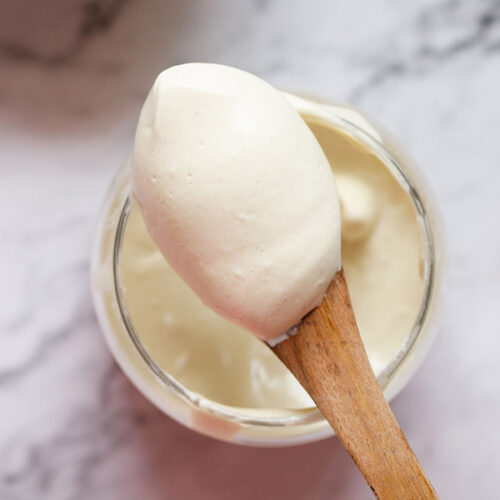

Eggless Mayonnaise Recipe (Plant Based)
This deliciously creamy vegan eggless mayonnaise recipe is even better than the regular stuff. It is made with cashews, oil, vinegar, dijon mustard, seasonings and spices. Use it in place of regular mayonnaise in any application.
Prep Time 5 minutes
Soaking Time 30 minutes
Total Time 35 minutes
Prevent your screen from going dark while making the recipe
Rinse cashews thoroughly in water. Drain all the water and discard it.
Place the cashews in a bowl and cover with enough warm water. Soak them for 30 minutes.
Drain and discard all the water from the soaked cashews and add nuts to a blender.
Also add dijon mustard, raw sugar, turmeric powder, black peppercorns and rock salt.
Add apple cider vinegar or lemon juice.
Add the sunflower oil or any neutral tasting oil.
While the blender is running, slowly add 7 to 8 tablespoons water in parts and blend until smooth and creamy.
Pour your completed vegan mayonnaise into a clean jar or airtight container. Seal it tightly and refrigerate.
This eggless mayo stays good for a month in the refrigerator. You can also freeze it for 3 months.
- Make sure to make this mayo recipe with raw unsalted cashews. It is okay to use cashew pieces, as long as they are raw and unsalted. You can also substitute cashews with almonds or macadamia nuts, if they are raw and unsalted
- It is very important to use a neutral flavored oil when making mayonnaise. Some good options are: canola, vegetable, grapeseed or avocado oil. Do not use oil which have unique aroma or flavors as your mayo will also have it. Avoid coconut oil, peanut oil, sesame oil, olive oil.
- You can use 1 teaspoon ground mustard powder in place of Dijon mustard.
- If you want to use this Veg Mayonnaise right away, then add only 4 to 5 tablespoons water. The mayonnaise thickens when refrigerated. So, 7 to 8 tablespoons water works perfectly if you have time to let it set up. If you opt to use less water to use the mayo right away, be sure to use the entire recipe or it will become too thick in the refrigerator.
- Remember to use an air-tight container to store the Eggless Mayonnaise in the refrigerator.
Nutrition Facts
Eggless Mayonnaise Recipe (Plant Based)
Amount Per Serving (1 tablespoon veg mayonnaise)
Calories 62 Calories from Fat 45
% Daily Value*
Fat 5g8%
Saturated Fat 1g6%
Sodium 78mg3%
Potassium 58mg2%
Carbohydrates 3g1%
Fiber 1g4%
Sugar 1g1%
Protein 2g4%
Vitamin B1 (Thiamine) 1mg67%
Vitamin B2 (Riboflavin) 1mg59%
Vitamin B3 (Niacin) 1mg5%
Vitamin B6 1mg50%
Vitamin E 1mg7%
Vitamin K 3µg3%
Calcium 5mg1%
Vitamin B9 (Folate) 2µg1%
Iron 1mg6%
Magnesium 24mg6%
Phosphorus 48mg5%
Zinc 1mg7%
* Percent Daily Values are based on a 2000 calorie diet.

Source link